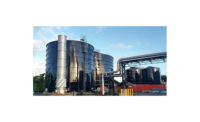Maximizing the value of food waste digestion

By Matt Hale, International Sales & Marketing Director for HRS Heat Exchangers
The past five years have seen tremendous growth in the anaerobic digestion (AD) sector in North America. The latest EPA data1 suggests that there are now more than 180 AD facilities processing food waste in the United States. These include dedicated food waste digesters as well as co-digestion of food waste at on-farm and water resource recovery facilities.
It’s easy to see why food waste AD has proved so popular. Processing organic wastes through anaerobic digestion not only cuts greenhouse gas emissions by diverting waste from landfill, it generates homegrown renewable energy and produces a biofertilizer (digestate), rich in valuable nutrients such as nitrogen, potassium and phosphorus.
Capacity and competition
In 2015 these plants processed some 12.7 million tons of food waste, producing 358,742 cubic feet of biogas per minute – enough to power almost 685,000 homes for a year. However, with up to 63 million tons of food being wasted across the supply chain in the US every year2, there is ample scope to increase the amount of food waste treated by anaerobic digestion. But, from an AD point of view, not all food waste is equal. The biggest source of feedstock for food waste AD plants is food and beverage processing, but this is actually the smallest source of food waste in the supply chain accounting for just 2% depending on the estimate used. The next biggest source of food waste comes from farms, accounting for around 10 million tons, or 10% of the total, while the distribution (25 million tons) and consumer (27 million tons) sectors generate the rest.
So while there is plenty of food waste to fill the current food waste AD capacity of 15.8 million tons, and still support more in the future, there is likely to be increasing competition for those feedstocks which are the easiest to obtain and process. Therefore, these feedstocks are likely to be subject to increasing competition and falling gate fees, making it more important than ever that food waste AD plants are operated efficiently, with every aspect of the process optimized to ensure maximum return on investment.
One area that many food waste AD operators are still missing out on is the potential extra income that could be made from the biofertilizer (digestate) end product. Dismissed as an afterthought by some in the past, today’s successful operators keep it firmly at the heart of their business. They understand that creating a quality end product, which can then be sold to farmers, growers and even gardeners – using as little energy as possible to do so – is essential for a thriving AD operation that will continue to appeal to investors.
Efficient digestate pasteurization
Pasteurization can greatly increase the salability of the digestate from food waste digestion, and is actually a legal requirement in many other countries. The process, which is often backed by an independent certification scheme, provides reassurance to farmers, growers and legislators that it is safe to be applied to land.
The 3 Tank Batch Sludge Pasteurizer System from HRS Heat Exchangers achieves this using up to 70% less energy than existing competitor technology. The system works on a three tank principle: while one tank is being filled, the second tank holds the digestate above 158oF, at the same time as the third tank is being emptied; each process lasts one hour.
Traditionally, systems that heat digestate in a tank use a heating jacket – a bit like waiting for a giant kettle to boil – and then dump the heat after it has served its original purpose. The HRS system, however, employs energy recovery and is typically two to three times more efficient. By transferring energy from the hotter (pasteurized) sludge to the colder (unpasteurized) sludge, energy consumption is reduced by up to 70%, maximizing the use of heat which would have otherwise been wasted. This also circumvents the need to install an additional heat source such as a biomass boiler, which could add hundreds of thousands of pounds to a project.
Flexible and adaptable
The inner tube in the HRS system’s exchanger which carries the digestate is a unique corrugated design; unlike the smooth tubes used in alternative exchangers. This boosts heat transfer by creating extra turbulence and also helps reduce fouling – as the digestate travels around the system, it’s less likely to stick to the tube wall – downtime and maintenance, as well as increasing the system’s lifespan.
With increased competition for feedstock among food waste AD operators, digestate stocks can fluctuate depending on the volume of feedstock being processed at the front end. It is therefore important that operators employ a pasteurization system which is capable of running a continuous process even when stock levels fall. HRS’s addition of four level temperature probes – three in the bottom of each tank and one in the top – means the tanks can be filled to half capacities should the demand or flow drop off, allowing for continuous and flexible digestate production. Without these probes, the system would be put on a ‘go slow’ waiting for the tanks to fill, which would not only require more heat but would also incur the expense of slowing down production or shutting the system and restarting.
It is also imperative that a pasteurization system is tailored to meet an individual plant’s needs. AD operators are now increasingly demanding systems which offer a reduced footprint, scalability and a flexible lead-time; all of which are standard with HRS. The system also uses the company’s in-house software to ensure full traceability so that users remain compliant with legislation and can troubleshoot any issues arising from a particular batch.
Overcoming digestate storage issues
While heat exchanger and pasteurization technology is helping food waste AD operators to create a quality digestate, the sheer volumes being produced can be difficult to manage. A typical 1.5 MW plant generates as much as 44,000 tons of liquid digestate each year, bringing significant economic and logistical challenges associated with its storage and transportation. And as best practice dictates that digestate should not be applied to land all year round, digestate storage is a major consideration for AD operators. In fact, spreading digestate at the wrong time of year, when the crop is unable to take full advantage of its nutrients, reduces its value and risks polluting the environment.
Reducing the liquid fraction can greatly help to overcome these issues. The Digestate Concentration System (DCS) from HRS superheats liquid digestate in a vacuum, increasing the dry matter typically from four per cent to 20 per cent and reducing the overall volume of digestate produced. This means that up to 60 per cent less storage capacity is needed and fewer lorry loads are required, helping curb a plant’s transportation costs and carbon footprint. The water removed by the process is then recovered and can be mixed with the AD feedstock, increasing the efficiency of the digester and reducing the overall amount of energy and water used.
Survival of the fittest
The use of intelligent heat exchanger, pasteurization and concentration technology could help food waste AD operators to recover nearly half the heat produced by their AD plant and assist them in producing a quality biofertiliser, at the same time as making cost and energy savings. Maximizing the value of digestate will give AD operators the best chance of not only surviving, but thriving in the face of greater competition for the most economic feedstocks and uncertain environmental regulations.
1 Codigestion of Food Waste in The U.S., BioCycle, https://www.biocycle.net/2018/07/06/codigestion-food-waste-u-s/
2 Food for Thought, Wells Fargo, https://wholesale.wf.com/food_for_thought/addressing-food-waste-in-america/
Looking for a reprint of this article?
From high-res PDFs to custom plaques, order your copy today!





